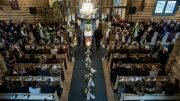This Easter, pilgrims visiting the Holy Sepulchre in Jerusalem, will see a tomb that shines. But above and beneath them,there lurks a potential disaster.
While Christians around the world get ready to celebrate the day when Jesus, according to the Bible, was resurrected from the dead, all rival denominations acknowledge that the sanctuary where it is all said to have happened, is in danger of
collapsing over the heads of tourists.
The restoration of the tomb where many Christians believe that Jesus was laid after the crucifixion, cost over 30 million, taking ten months to complete.
The small building that accommodates the possible grave site wasn’t only covered by a 200 year old layer of dust and grime, but the entire structure was in a miserable condition. Now both the dirt, and general decay have been taken care of by experts from the Technical University of Athens, but during the work, the professors detected a far greater problem.
The church that surrounds the tomb itself is leaning, and on loose foundation materials, which are also riddled with tunnels and cavities. In short, both the tomb and parts of the Holy Sepulchre are in imminent danger of collapse.
‘It won’t happen as a slow collapse, it will be a sudden, dramatic disaster’, said project manager, Antonia Moropoulou,to National Geographic, which has followed the restoration project closely.
With the exception of an iron infrastructure that the British managed to install in the tomb in order to prevent collapse before they withdrew from Jerusalem in 1947, nothing has happened since to take care of either the tomb, or the Holy Sepulchre over the course of the past 200 years.
The reason for this is that three different denominations claim a protective right over each part of the Holy Sepulchre.
Over the years, the relationship between them, at their best, have begun freezing over. Occasionally, scuffles have broken out between priests and monks inside the sacred place, which are often sparked by seemingly trivial matters, such as when
someone forgot to close a door to one of the chapels inside the church building.
The rivalry between the Greek Orthodox Church, the Roman Catholic Church, and the Armenian Orthodox Church, have short-circuited the possibilities for essential restoration work.
After many years of deadlock, such would probably still be the case had it not been for the Israeli authorities putting their foot down for the sake of tourists’ safety last spring, when they closed the part of the Holy Sepulchre where the tomb itself is located.
‘Someone had to push us to action. Unless the Israeli government had involved itself, nothing would have been done’, said the Armenian priest, Samuel Aghoyan, to the New York Times last year, according to the daily newspaper.
It turns out that it is external pressure which may again force the sometimes rival churches to continue the local agreement.
During the restoration work, it was revealed that the place where the Holy Sepulchre was first discovered, around the year 325 by Emperor Constantine, had formerly been a burial place for the richest in society. This means that most of the 22-ton columns that hold the dome up, rest on porous and partly holed through limestone.
A large-scale excavation, drainage and recovery process is necessary to prevent one of Christianity’s holiest sites crumbling, acknowledged the Greek experts.
According to National Geographic, work on ensuring the security of the ground under the Holy Sepulchre is estimated to cost NOK 55 million and will take another ten months. Time will tell if new secrets of the site might be revealed during this work.
Some have argued that it was a small miracle when Catholics, Armenians, and Greek Orthodox christians managed to agree to the restoration of the tomb. Say a prayer that the miracle will continue, and all will be safe and well until the work is completed.
Source: NTB scanpix / Norway Today




